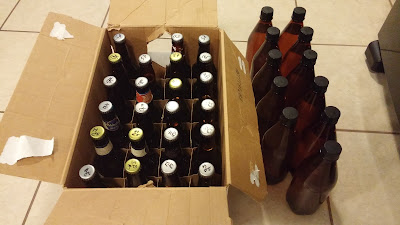So here is the run down on what happened. I got a little....adventurous. Being the first time doing this recipe I was content with following the directions explicitly. Well I did...but then I didn't, and the results are amazingly, smooth, balanced, fruity, and delicious.
I waited until my hydrometer read 0.096 and racked into TWO 3 gallon carboys. One was going to follow the directions from the website, and the other was getting dry hopped. At first I was worried because I didn't have enough liquid to reach the neck of the carboys when separated, but after doing some research online it seemed not to be an issue with this wine due to its high acidity levels. I am going to have to look into the chemistry of that sediment a bit more later, but I will admit that the wine does not taste in any way like it get oxygenated. I had also bought a degaser wand and hooked that up to my drill. I am thinking that helped to release a lot of carbon dioxide to create a blanket over the liquid. I put a bung on right after degassing.
The degassing was done AFTER I stabilized the wine by adding potassium metabisulfate, which also works to remove oxygen from the wine, and potassium sorbate to halt any further fermentation when back sweetening. Since I knew that this wine was going to be served immediately once bottled and not last the summer or fall, I was okay with putting a shelf life on this wine by using the sorbate. To top it all off, going for clarity, I added sparkolloid.
Ok, so I let that all sit for two more weeks. The dry hopping was just done with 0.65g of Glacier hops that I got from Irish Rover, and those were added at the same time the Kmeta and Ksorbate were added.
 |
| Dry hopped batch. |
 |
| Original recipe batch. Clear. |
I got ready for bottling and went with a combination of glass and plastic screw top bottles from a Mr. Beer kit that a friend no longer wanted. The intention of the plastic bottles was for my wife to take some of this on a float trip where glass was not allowed.
 |
| I just don't have time to remove the labels from all of my bottles...I am getting there. |
Next came the tricky part of back sweetening. I say tricky, because I was dealing with two factors.
- The SP website gives sugar amounts for one 5 gallon batch. I have two batches now, and they are not equal amounts, nor were they of the same taste with one being dry hopped.
- The wife needed to approve.
 |
| Original in all the brown bottles, SP caps were original, and SPH caps were the hopped ones. |
Matuz
1 comment:
Can confirm: Both batches are great. The dry hopped is outrageous.
Post a Comment